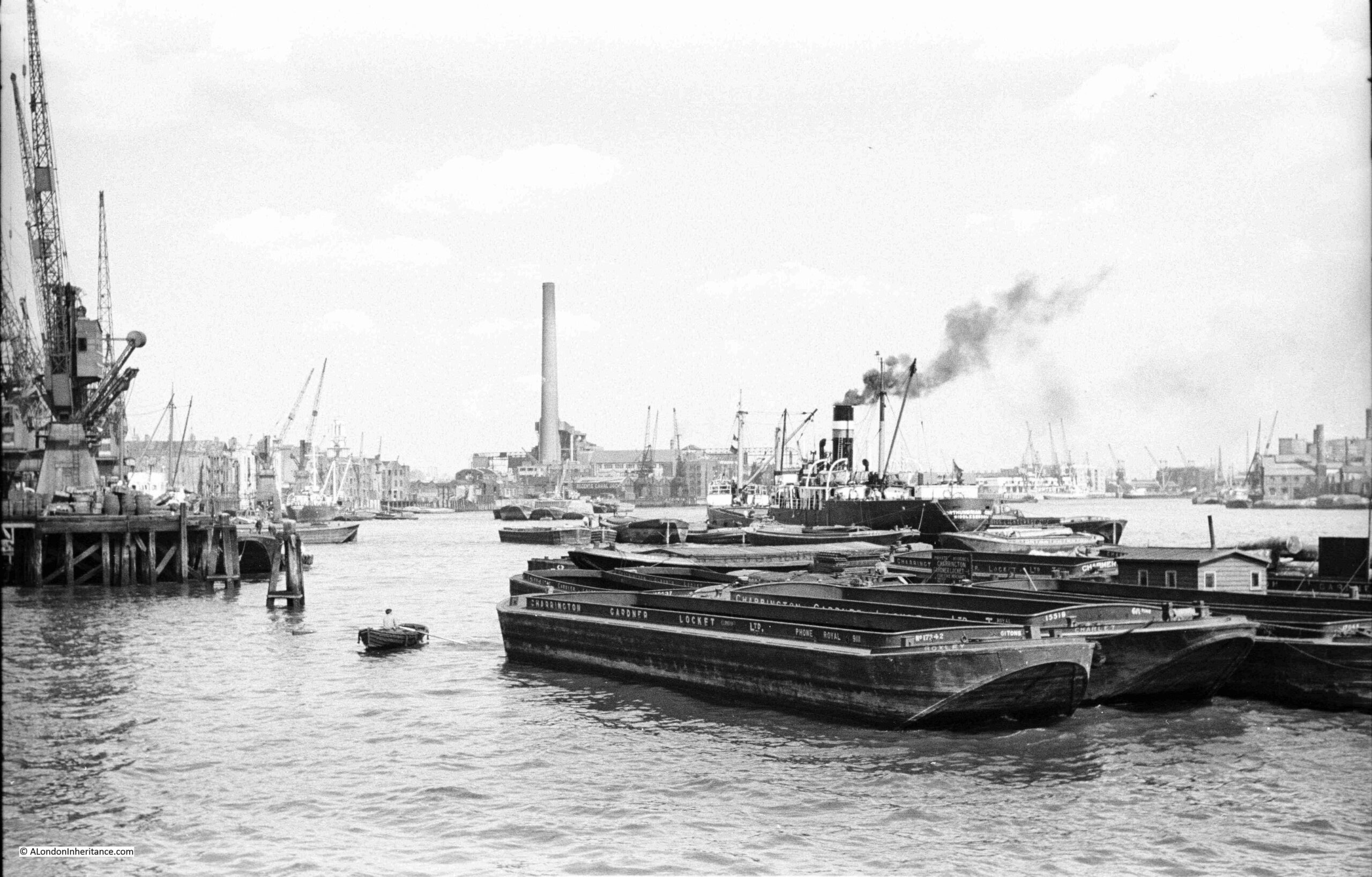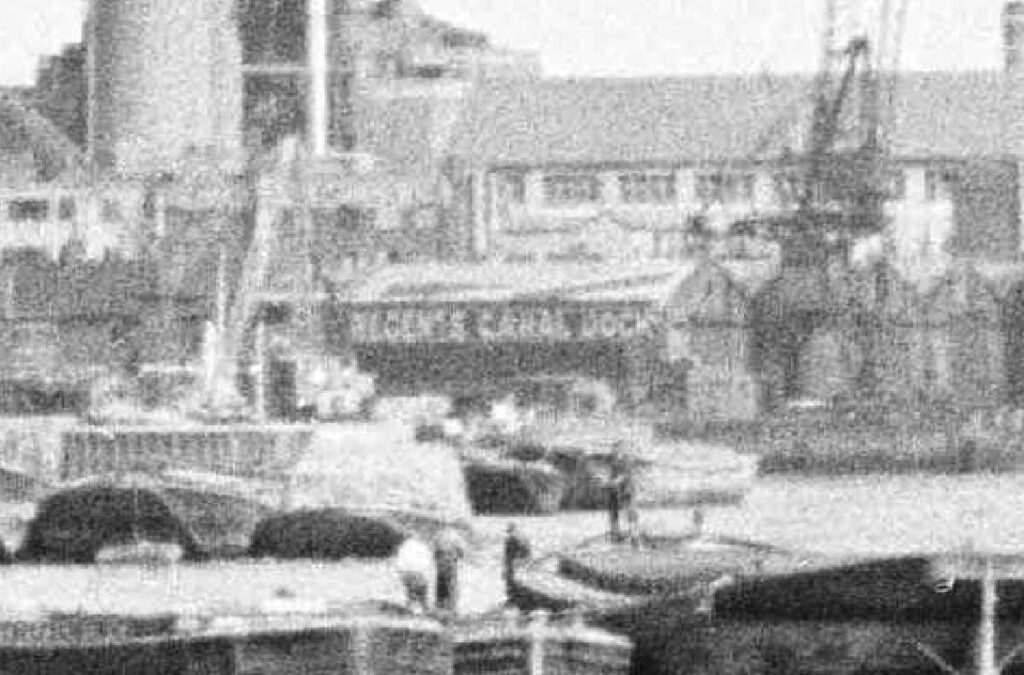(Dates for my new walk at the end of the post) The following photo was taken by my father from the eastern end of the King Edward VII Memorial Park in Shadwell. It is looking east along the Thames towards Limehouse:

The photo shows this stretch of the river as it was in the late 1940s. A busy place with docks, wharves and cranes, with barges and ships along the river.
The tall chimney is that of Limehouse (also called Stepney) power station. An electricity generating station that ran on coal transported along the river. The power station was built in 1907, however the tall chimney was added 20 years later in 1927 due to complaints about the amount of pollution that was being spread around Limehouse by the much smaller original chimneys. At the time of building, it was the tallest chimney in London at a height of 351 feet.
The power station was closed in 1972 and demolished soon after.
Just in front, and to the right of the power station chimney is the entrance to the Regent’s Canal Dock (now Limehouse Basin). Although the entrance is hard to see, the warehouses with the name of the dock, on the east side of the entrance to the dock from the river can be seen in this extract from the above photo:

The title for the walk “Limehouse – A Sink of Iniquity and Degradation” came from the book “Limehouse through Five Centuries” written in 1930 by the Reverend J.G. Birch of St. Anne’s, Limehouse. He used the phrase in his introduction to the book, and also added that he hoped that the book would help dispel this myth.
Limehouse has always had an air of mystery and intrigue, an exotic and dangerous place to those who did not live or work along the river.
The 1916 book Limehouse Nights by Thomas Burke featured a number of short stories centred on Limehouse, the opium dens and the Chinese community, which were also the background to the stories of Dr. Fu-Manchu by Sax Rohmer. The works by Burke and Rohmer featured appalling stereotypical views of the Asian community then living in Limehouse.
Stories about Limehouse exploited themes of violence, crime, sex and drugs and how the import of opium resulted in the exploitation of English women, often to sell opium in the fashionable West End.
The image of Limehouse as a place of intrigue and mystery continues to this day, with the 1994 book Dan Leno and the Limehouse Golem by Peter Ackroyd, on which the 2016 film The Limehouse Golem was based.
Whilst there were opium dens, crime and violence, Limehouse was a hard working place, based around the trade and industry that grew along the Thames. The Chinese population were frequently sailors who had settled in Limehouse and married local women, along with a temporary increase in numbers when ships with Chinese crew docked. Their numbers though were relatively low, not as large as popular literature of the time might suggest.
Limehouse was an early site of ship building. From Limehouse, sailors and traders set out along the Thames to cross the oceans of the world. Industry, warehouses and docks lined the river, with cramped housing alongside polluting factories.
Limehouse provided access to the Thames for the inland waterways, with the Limehouse Cut and the Regent’s Canal providing access to the river from the rest of the country. In the Regent’s Canal Dock (now the Limehouse Basin), ships unloaded all manner of cargo, including coal, timber, fruit and ice.
There was technical innovation, hydraulic power and an electricity generating station running on coal delivered via the river. The London & Blackwall Railway cut through Limehouse on a brick viaduct, paving the way for the Docklands Light Railway.
The decades after the 2nd World War were not kind to Limehouse as trade along the river slowly declined and industry closed or moved away.
From the late 1980s onwards, Limehouse was transformed, with some major projects being driven by the developments on the Isle of Dogs just to the east.
I have long been fascinated by Limehouse, a place that for centuries was shaped by the relationship between the land and the river. Whilst today that contact is maintained by Limehouse Basin, the rest of Limehouse is now just a spectator to the activity on the river.
This walk will explore the history and development of Limehouse from the 15th century to the present day. The people, those who settled in Limehouse, the relationship with the River Thames, trade, waterways, tunnels, streets, pubs and church, along with some of the reality of the opium dens.
As with the Reverend J.G. Birch, my aim with the walk is to dispel some of the myths about Limehouse and focus on the real history of this fascinating part of east London.
The walk will start at Limehouse DLR station and end at Westferry DLR station. It will take around 2 hours 30 minutes and is a walk of slightly over 2 miles.
The schedule of walks is listed below. Click on each date to get to the Eventbrite booking page:
Sunday 30th July at 11:00(Sold Out)Sunday 6th August at 11:00(Sold Out)Thursday 10th August at 13:00(Sold Out)Saturday 19th August at 11:00(Sold Out)Sunday 20th August at 11:00(Sold Out)Thursday 24th August at 13:00(Sold Out)Sunday 27th August at 11:00(Sold Out)
Just added a couple of new dates as the original set sold out:
Or for an overview of all the walks on Eventbrite, then click here.
I look forward to showing you around this fascinating part of east London.

Daniel Farson lived in Limehouse in the 1950’s and wrote “Limehouse Days”.
Very interesting
Last hurrah of the British Empire.
Maevelous
Limehouse also featured significantly in recent BBC adaptation of ‘Great Expectations’ with scenes in opium den.
You might begin with the name of your starting point, which to locals of a certain vintage will always be Stepney East .. the vicinity of Limehouse being situate the other side of the entrance to Rotherhithe Tunnel.
While local boundaries have been messed about with since time immemorial (eg Whitechapel, Shadwell and Mile End), Limehouse station ought to be where the next stop is on the DLR, at West Ferry.
Nitpicking, I know .. but irritating all the same when you think of fresh-out-of- college planners with ni skin in the game.
My ancestors lived in various locations in Limehouse, including “Limehouse Hole”, so I’m really hoping to come along to one of the walks.
Thank you fir all this great information, my Reynolds family, lived in Limehouse Causeway , In 1760 , the father was a millwright, his two sons were transported to New South Wales, in 1791 on the Antlantic for stealing 300 weight of lead from the green house roof of Captain Jeffrey Jackson, of the East India Company.
Wish I could join you but not possible . My paternal grandfather born 1891 in Cable Street. He came from generations of watermen/ lightermen but got a job as a clerk and from then on always worked in an office.
In describing the old Limehouse to “mystery and intrigue ” should be added glamour. Because of the oriental connection my father and grandfather ,who were born and raised there until bombed out in WWII, felt Limehouse was more swish and exciting than the more prosaic neighbouring docklands with their mainly Irish dockers.
According to them there certainly were opium dens which were mainly frequented by the Chinese sailors, the Chinese family men preferring a quiet opium pipe at home. Getting tanked up and aggressive on a Friday night at the pub wasn’t their idea of fun. Each to their own.
I think ‘ Limehouse Nights ‘ needs to be read in the historical and social context of its time. Not to offend, but its language follows in that old cockney tradition of ‘ taking the piss’ a type of iconoclastic humour used as a great leveller and inclusion. Don’t the non chinese get criticism too in the book. Who’s the hero in the “Broken Blossoms” story ?
I was down there recently and walked a circuit around the Basin. The many information boards were interesting but do need renewing. I found the ‘newly restored’ Brunel’s hydraulic accumulator tower looking far from accessible with a filthy and heavily chained entrance that obviously hasn’t been opened in decades. Shame on CRT letting our heritage buildings deCriscay.
You forgot to mention “Limehouse Blues”
* As to whether you can sing it or say it these days .. who would know?